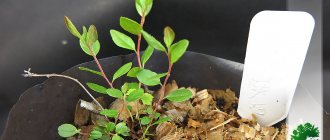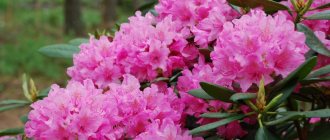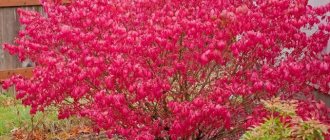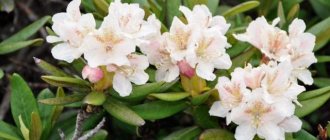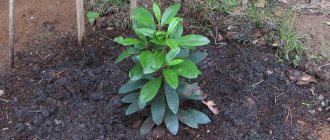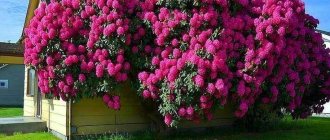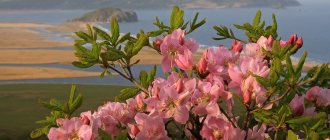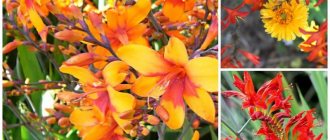Description of Japanese rhododendron
In the process of long-term selection, about 12 thousand varieties of Japanese rhododendron were bred. Most of the plants reach a height of 2 m. Flowering duration is 2 months (May and June), with up to 400 flowers blooming on 1 bush. Bushes that have no foliage or are just beginning to appear look very beautiful, but the branches are strewn with flowers. Japanese rhododendron inflorescences are formed from 10 or more corollas, most often having an orange-yellow hue. After the corollas wither, fruits are formed - boxes with very small (smaller than poppy seed) seeds that ripen by October.
The life expectancy of the plant is high, the tallest varieties grow up to 100 years. There are varieties with erect and creeping stems. Mature shoots have a pronounced brown tint, and the most tender young and bare shoots have a green tint. The root system is fibrous, without hairs.
In the catalogs of planting material manufacturers you can find many varieties and photos of Japanese rhododendron. The most common shades are orange, yellow, pink and white.
General information
Deciduous Japanese rhododendrons - representatives of the Heather family - grow up to 2 m in height. There are about 12,000 varieties of the crop, which were bred by European breeders. Depending on the variety, rosewood buds bloom in April-May. Flowering continues for a period of 2 weeks to 2 months. In the description of the culture, it is noted that on one Japanese rhododendron bush up to 400 flowers with a diameter of up to 8 cm are formed. During this period, the plant is strewn with fragrant corollas so that no branches, foliage, or crown are visible. The Japanese salmon rhododendron blooms especially beautifully; its high winter hardiness makes the variety popular in gardens in the Moscow region.
Deciduous Japanese rhododendrons form inflorescences of 6-12 corollas. After flowering, fruit boxes with miniature seeds-grains are formed. In one place, the culture can grow up to 40-50 years, the life expectancy of individual representatives of the genus reaches 100 years.
Varieties of Japanese rhododendron
The classic orange Japanese rhododendron will brighten up any area, but the plant looks even more beautiful when surrounded by other shades. The following varieties are most popular among gardeners in central Russia.
Japanese salmon rhododendron
The hallmark of this variety is not only the bright shade of lush and large inflorescences. The winter hardiness of Japanese salmon rhododendron is its valuable quality, which made it possible to grow it not only in the middle zone, but also in the front gardens of the Moscow region. It is easy to recognize the variety by key features:
- height – up to 2 m;
- flowers are salmon-colored, up to 7 cm in diameter, collected in inflorescences of 6-12 pieces;
- flowering duration - 3 weeks from mid or late May;
- elongated green foliage 10-12 cm long acquires a fiery hue by September;
- gray bark.
For planting, seedlings aged 2-4 years are purchased. The unpretentious Japanese salmon rhododendron is planted where there is not sun all day, otherwise the delicate flowers will easily burn. Places near fences are good. The variety is very moisture-loving, but requires fertilizing once every 2-3 years.
Rhododendron japonica cream
The creamy shade of the petals in this group of varieties is often combined with a bright yellow flower core and equally large stamens. A pleasant delicate aroma is characteristic of all Japanese rhododendrons. Its peculiarity is that it does not tolerate proximity to large trees, but it thrives on lawns surrounded by grass and on slopes. It is advantageous to plant in areas with large differences in elevation, so it is often used to create terraced landscape compositions.
Depending on the variety, the height of the bush reaches 1.2-2 m, and grows in one place with proper care for up to 40 years. The leaves grow up to 4-10 cm in length, and the flowers are collected in inflorescences of 6-12 pieces. The corollas are so lush that the foliage behind them is almost invisible. By autumn, the foliage on the bushes turns yellow-purple instead of dark green.
Rhododendron japonica Babushka
Belongs to the dwarf varieties. The compact bush grows only 50 cm in height and width. The semi-double carmine-pink flowers are very lush. Only the red Japanese rhododendron looks brighter. The shiny dark green foliage turns yellow in autumn. The variety is semi-evergreen.
It is recommended to plant in semi-dark areas. Belongs to winter hardiness zone 6. Loves abundant watering and mulching. Bushes require pruning once a year - late autumn or early spring before buds open.
Rhododendron japonica Schneeperle
Azalea rhododendron japonica Schneeperle is one of the earliest varieties. Flowering begins in mid-April and lasts until the end of spring. Pale white flowers look great in holiday bouquets, such as wedding bouquets. The corollas of the flowers are relatively small - 4-5 cm in diameter, but very lush, reminiscent of tiny roses.
The bush is unpretentious, but grows very slowly. A 10-year-old plant has a height of only 35 cm and a width of 55 cm. The main application is the formation of borders in multi-row decorative plantings. The peculiarity of the variety is that it requires formative pruning after flowering in June. This gives the plant an incentive to form flower buds for the next season. Withstands frosts down to – 29 °C. The root system is shallow, prone to growing in breadth. It is highly not recommended to bury the root collar, as this can lead to the death of the bush.
Rhododendron japonica Snow White Prince
This variety can also be found on sale under the name White Prince. The flowers are either completely snow-white or with a soft pink center. It looks especially impressive next to the orange Japanese rhododendron/azalea. The bush is tall - up to 2 m in height. The flowers are medium-sized - 6-8 cm in diameter. The leaves are elongated, green in color, up to 10 cm long. Winter hardiness is average; in regions with frosty winters, covered agricultural technology is recommended. Planting material – 3-year-old seedlings. Younger seedlings obtained from seeds are grown in greenhouse conditions. For planting in open ground, choose a shaded place, well protected from strong winds and direct sunlight.
Important! Ideal neighbors are deciduous shrubs and conifers.
Brief definition for garden rhododendron
The Japanese azalea belongs to the Rhododendron genus of the Veresaceae family. The miniature Japanese azalea belongs to the garden group of evergreen flowers ; it does not shed its leaves in the fall.
On a note. The homeland of Japanese azalea is considered to be Japan, China, the Caucasus and India. Thanks to the efforts of breeders, this hybrid variety feels great in garden plots and cottages - this is one of the main differences and advantages of the Japanese azalea from its capricious relatives.
Winter hardiness of Japanese rhododendron
Not all varieties are equally good for regions with frosty winters. Whether a particular variety is suitable for a given area must be clarified in advance. Here is a list of the most winter-hardy varieties that can be grown even without covering the bushes for the winter:
| Name | Winter temperature limit, °C |
| Grandmother | — 23 |
| Golden Lights | — 42 |
| English Roseum | — 34,4 |
| Karens | — 31 |
| Mount Saint Helens | — 32 |
| Nova Zembla | — 32 |
| PJM Elite | — 32 |
| Rosy Lights | — 42 |
| Roseum Elegans | — 32 |
| White Lights | — 42 |
In its natural habitat, Japanese rhododendron grows on mountain slopes at an altitude of up to 2000 m above sea level.
Important! The main condition for a favorable winter is reliable protection from the wind that blows away the snow.
How to identify a deciduous variety
One of the differences from evergreen varieties is more abundant flowering. Deciduous varieties have more peduncle branches than semi-deciduous or evergreen varieties. Another difference is the riot of autumn colors on the leaves of deciduous varieties.
Autumn colors are in full bloom on deciduous varieties
With the arrival of autumn, the leaves change color from fiery yellow to crimson red. The decorative properties of the bush from spring to late autumn remain at their best. These exotics do not grow too quickly and lend themselves very well to pruning and decorative crown formation. The frost resistance of the bush also influences the choice towards deciduous.
Attention! Residents of Siberia and similarly harsh climatic zones should think about covering rhododendron for the winter. Deciduous varieties are less picky about growing conditions and are more hardy, so they are suitable for beginner gardeners and future rhododendron lovers
Deciduous varieties are less picky about maintenance conditions and are more hardy, so they are suitable for beginner gardeners and future rhododendron lovers.
Planting and caring for Japanese rhododendron
It is quite possible, if desired, to grow a beautiful Japanese rhododendron from seeds. This is an interesting matter and will take more than one year. The fact is that young plants in the first year of life are extremely demanding of care, so sowing is carried out in containers where bushes are usually kept for up to 3 years. Only after this are they transferred to flower beds or put up for sale. The older the bush, the higher it is valued. If the average price of a 3-year-old Japanese rhododendron ranges from 300 to 1000 rubles, then for a 7-year-old one the fair value is from 15 thousand rubles.
Long and slow growing season is the main reason why varietal Japanese rhododendrons are sold in specialized stores in the form of seedlings of different ages. It is enough to carefully deliver it to the site and plant it in the chosen place in order to admire its lush spring flowering for many years to come. The growth in one year is small; low-growing varieties can increase in height by only a few centimeters per season.
Selection and preparation of a landing site
The vast majority of Japanese rhododendrons do not tolerate direct sunlight. It is recommended to plant bushes where the sun appears only for some part of the day - morning or evening. It is optimal to plant bushes along fences or borders, as well as under the cover of a facade or other bushes. In a completely open clearing, where the bush cannot hide in the shadows for even a second, its flowers and leaves will be seriously tested. The risk of death due to burns is very high.
The soil in the places where the plant comes from is least similar to black soil. In fact, it is a complex substrate in which all kinds of plant debris abound: branches, pine needles, foliage. To plant bushes, prepare fertile soil by mixing it generously with mulch and adding clean river sand for additional looseness. In clay and heavy soil, Japanese rhododendron will wither. Excellent additives are peat and rotted pine needles. The acidity of the substrate should be high; Japanese rhododendrons do not like neutral or alkaline soils.
Seedling preparation
Since planting material comes from nurseries where the bushes were kept in greenhouse conditions, they need to be acclimatized before planting in open ground. To do this, the tub with the plant is hardened. First, for half an hour, and then gradually increasing the time interval, it is taken out into the fresh air at the warmest time of the day, leaving it in partial shade. After 7-10 days, you can begin planting in a pre-prepared hole.
Rules for planting Japanese rhododendron
The root system of the bush does not exceed 1 m in height for an adult plant. The planting hole is dug to a depth of 50 cm. Vermiculite or cheaper expanded clay and fine crushed stone must be poured onto its bottom for optimal drainage.
The removed soil is thoroughly mixed with pine needles, peat, mulch, and a little complex mineral fertilizer is added. For planting, choose a cloudy but warm day. After placing the roots in the hole, they are covered with the prepared substrate and watered abundantly. A funnel is formed around the trunk of the bush so that when watering the water does not spread past. The top of the soil must be sprinkled with mulch. The root collar cannot be buried; it must be level with the ground level.
Watering and fertilizing
Japanese rhododendron does not tolerate drought well. If there is a natural or artificial pond on the site, then bushes can be planted along its banks. In other cases, throughout the warm season, Japanese rhododendron needs regular, abundant watering. Mulching the planting with pine needles or dry leaves will help prevent critical drying out of the soil under the bushes.
Japanese rhododendron requires almost no feeding. Once a season, a sodium-potassium-phosphorus combined mixture is added at the rate of 5-10 g/m2. The rest of the plant comes from rotting plant residues. Several times during the summer, pine needles, peat, and heather soil are added under the trunk.
Important! Loosening is never carried out.
Trimming
The picture shows what a Japanese rhododendron looks like after pruning (2). They do it several times. There are different types of pruning:
- sanitary – in early spring, remove broken and frozen branches from the bushes;
- formative - before flowering, get rid of bare shoots without branches to get a symmetrical, neat crown;
- rejuvenating - after flowering, performed to stimulate growth if necessary, involves shortening the shoots by 20 cm.
Preparing for winter
Rhododendrons in Japan, growing on gentle mountain slopes, tolerate snowy winters well and do not require any care. In Russia, it is better to take care of the bushes in advance, increasing the chances of the Japanese rhododendron to survive the winter safely.
First of all, pruning is carried out, removing branches affected by diseases and pests. If the bush is old enough, then you can shorten the shoots by 20-30 cm to stimulate the active growth of dormant buds. Winter-hardy varieties do not need shelter, but semi-evergreen varieties will require shelter. Agrofibre is used for this. The covering material has good breathability, but does not allow the branches of the bushes to freeze out in dry winters with little snow.
Another important activity after the Japanese rhododendron leaves fall is watering and fertilizing. Up to 10 liters of water are poured under each bush, dissolving 8 g of superphosphate and 6 g of potassium sulfate in it.
Care
The first fertilizing will be required after 2 weeks. Specialized garden stores have ready-made complex fertilizer. Basic rules for caring for shrubs:
In spring, after frost, it is advisable to trim dry branches. They will be clearly visible when buds appear on the tree.
Advice. Mulching not only prevents the appearance of weeds, but also retains the moisture necessary for Japanese rhododendron.
Reproduction
Japanese rhododendron lends itself well to propagation by cuttings, layering, and dividing old bushes. Rare hybrids are grafted onto the trunks of winter-hardy varieties. If you want to get an exact copy of your favorite Japanese rhododendron, you should cut a cutting of 15 cm in length in the spring. The bottom 2-3 leaves are removed. A branch of Japanese rhododendron is placed in moist soil and expected to take root for 2-3 months. If by August the root system of the bush has formed of sufficient size, then it can be planted in open ground, otherwise it is postponed until next year. In winter, containers with cuttings are left in a lighted room at a temperature of + 8-12 ° C.
Design with rhododendrons
Rhododendrons planted in groups look stunning, especially when placed along the edges of lawns, near paths, and near ponds, pools and fountains.
Rhododendrons are very decorative next to conifers. The latter, in turn, will protect the “sissies” from cold winds, winter drying out and the spring sun.
Representatives of the decorative forms of common juniper, Cossack, horizontal and Virginia, low-growing forms of western thuja, common and gray spruce, mountain and Scots pine are suitable for “cohabitation”.
Rhododendron Kazimierz Odnowiciel, Royal Violet
An evergreen hybrid rhododendron, up to 1.2-1.5 m high. A variety of Polish selection from the “Royal Rhododendrons” series, named after the Polish Prince Casimir the Restorer. The flowers are large, pink with a light center and a light brown dotted pattern. Flowering begins in early June and continues for 2-3 weeks.
Rhododendrons go well with their “relatives” from the heather family - heathers, cranberries, blueberries, lingonberries, kalmia, wintergreen. Next to them, bulbs (saffron, narcissus, tulips, scillas, muscari), ground cover plants (sedum, hosta, heuchera, pachysandra, periwinkle, saxifrage) and ferns (shield, adiantum, cystopteris) are comfortable.
Rhododendron Toucan
Deciduous shrub up to 2 m high. Blooms in late May - mid-June. The flowers are light cream to lemon with a pink tint.
In Japanese gardens they live in complete harmony with representatives of the natural flora of Japan: aralia, Japanese larch, and sacred euonymus.
Diseases and pests
With insufficient aeration of the root system, Japanese rhododendrons suffer from numerous fungal diseases. For prevention, it is recommended to regularly treat the bushes with a solution of Bordeaux mixture.
If the soil is not acidic enough, Japanese rhododendrons may suffer from root rot. This can only be corrected by increasing the acidity of the soil, for example, sprinkling the soil with pine litter and peat. Solutions of colloidal sulfur, ammonium nitrate, and potassium sulfate also help.
Numerous garden pests, common in central Russia, affect cultivated and wild varieties of Japanese rhododendron. Insecticides showed good effectiveness: “Iskra”, “Aktellik”, “Fitoverm”, “Aktara”.
Selection of varieties by groups and cultivation characteristics
In order not to make a mistake with your choice, before purchasing, it is important to familiarize yourself with the individual properties of each specimen. First, find out everything about the type and variety, and then purchase it
Hybrid rhododendrons are the most popular in ornamental gardens
Garden azalea is an outdated name for open ground shrubs. Recently they are called rhododendrons.
For ease of cultivation, experts divided the shrubs according to the following characteristics:
1deciduous, those that lose their leaves in the fall, like most shrubs of the botanical department of angiosperms
2Evergreens are covered with leaves all year round. Growth renewal occurs gradually, replacing old leaves with young shoots
Based on the results of sales statistics, it has been established that domestic gardeners willingly buy hybrid rhododendrons. Thanks to breeding, it is possible to choose varieties of different colors and sizes. Among them there are dwarf forms and large shrubs.
The following assortment is popular:
Large-flowered
Large-flowered
Berryrose is an azalea with a wide, straight silhouette of a dense crown. The flowers are pink with yellow splashes.
Kilian, Il Tasso, Strawberry Ice have different shades of pink.
Canon Double - triple-colored variety. Flowers in shades of yellow, cream and pink. Green buds are reddish.
Xardas are light-loving shrubs of medium size, up to one and a half meters. Spectacular double flowers are filled with fiery orange color. They have a strong pleasant aroma.
Diorama, Doloroso, Fireworks, Fireball, Gibraltar, Golden Eagle are varieties with different shades of orange.
Janita, Nabucco - hybrids with red flowers.
Japanese
Japanese
Allotria, Bubushka, Eisprinzessin, George Ahrens, Roccoco - are distinguished by bright crimson shades.
Elsie Lee, Ledicanens - varieties with lilac flowers.
Multiflora
Multiflora
Album Novum is 3 m high, blooms in May and June with white flowers.
Alfred - average bush size - 1.5 m, purple flowering.
America is a vigorous shrub up to 4 m high, with bright red large flowers and an exceptionally frost-resistant variety.
Bel Canto is an evergreen hybrid with an average growth force of 1.20 m in height. The inflorescences are golden yellow. It is recommended to plant in cozy places protected from the wind.
Kolsap is a bush with a dense crown and a wide straight silhouette. The average height is 1.30 m. The color of the flowers is double, the middle of the bud is purple ruby, the edges are white. The outer side of the petals is purple. It blooms much earlier than most rhododendrons in early May. It has good frost resistance.
Eskimo is a bush with a dense crown, spherical in shape. By the age of 10 it grows up to one and a half meters. Large light green leaves fall off in the winter. The flowers are white with a delicate lilac tint and a greenish-yellow spot in the middle of the inflorescence.
Evergreen Foresta
Evergreen Foresta
Bad Elzen is an evergreen low-growing bush, hemispherical in shape. The leaves are light green, leathery, small. Intense red bell flowers bloom in the first half of May. Needs shelter for the winter.
Scarlet Wonder is a stocky rhododendron with lush evergreen foliage. By the age of 10 it grows up to 50 cm in height and 120 cm in width.
Late spring frosts are extremely dangerous for a hybrid!
Application in landscape design
Landscape designers widely use rhododendron in their work, as it is unpretentious and at the same time blooms beautifully .
Before using a shrub in landscape design, it is necessary to take into account the height and spreading nature of the bush, the shape and size of the leaves, the color of the flowers and the time and duration of flowering. Also important is the bush’s tolerance to weather conditions.
Experts group rhododendron with other trees, shrubs and flowers , which ultimately allows them to achieve a special picturesque effect.
Rhododendron is widely used in landscape design
Having studied all the features of planting and caring for Japanese rhododendron, it will be easy for any gardener to grow one or more beautiful shrubs on their plot and enjoy their amazing beauty.
Preparing for winter
Japanese salmon rhododendron is frost-resistant and can survive the winter without shelter. But no one can predict whether winter will be snowy. Therefore, it is better to play it safe and prepare the plant for wintering. Young bushes up to two years old also need obligatory shelter.
In addition to shelter, rhododendron also needs to receive moisture in winter. To do this, in the period before frost (from early autumn), you need to water the plant every other day, with about 12 liters of water. After this, a thick layer of pine bark mulch is laid. When frost occurs, the lower branches are sprinkled with compost. You can use pine needles or peat.
Main types and varieties with photos
Bearded irises
Based on the shape of the flower, root irises are divided into non-bearded and bearded. Bearded plants received this name due to the presence of shaggy hairs on the surface of the petals. They have their own classification (medium-sized, standard medium-sized, connecting medium-sized, tall, border, small-flowered, medium-sized, miniature dwarf, standard dwarf, arylbred, table, arylbred and aryl, aryl-like arylbred and aryl, non-aryl-like arylbred). However, only scientists use this classification, and ordinary gardeners know these plants as bearded irises of various sizes.
Iris germanica
The tall bearded iris is also called Germanic. This plant has several hundred different varieties and is the most popular of all bearded irises. The most popular varieties are: Baltic Sea - a highly corrugated flower with an intense blue color and blue beards; Bewilderbest - corrugated flowers are painted in burgundy-reddish-cream color, and on the surface there are streaks and stripes of whitish and yellow color; Acoma - sky blue color combined with ivory, and also has a lavender border. It is very popular in America.
Non-bearded irises
These irises include: Japanese, spuria, Californian, Siberian, Louisiana, marsh, as well as other irises (interspecific and specific). The most popular in mid-latitudes are:
Siberian iris
It can be painted in various color shades from dark purple to blue. However, at the moment there are approximately 1 thousand different varieties, the color of which can be very different. For example, white Snow Queen; Batts and Sugars are yellow in color and have a whitish border; The Imperial Opal bush reaches a height of 80 centimeters, and its lavender-pink flowers have a diameter of about 10 centimeters. The flowers of this plant are very beautiful, but have no smell.
Japanese iris (Kempfler's, xiphoid)
Orchid-shaped flowers are very large in size (up to 25 centimeters in diameter), and they are fragrant. Thanks to breeders in Japan, the double (also called hana-shobu) and multi-petaled Japanese iris were born. But these species are not frost-resistant. For middle latitudes, it is recommended to choose: “Nessa-No-Mai” - the diameter of the whitish-purple flowers can reach 23 centimeters; "Solveig" - flowers are painted in a pale lilac color; “Vasily Alferov” - non-double flowers have an inky color.
Iris spuria
This very graceful plant is similar to the bulbous iris xyphium, but stands out for its large size. Not afraid of drought and frost. The most spectacular varieties: Lemon Touch - lacy lemon-yellow flowers have a dark golden color, the height of the bush is up to 100 centimeters; Transfiguration - the bush can also reach 100 centimeters in height, the color of the flowers varies from blue-violet to dark purple, the signal is bronze; Stella Irene - the bush reaches 90 centimeters in height, black-purple flowers have a small golden signal.
Swamp iris (false calamus)
This species, unlike others, prefers to grow only in moist soil. The flowers can be painted in various shades of yellow, and it is most often used to decorate artificial reservoirs. The most popular varieties are: “Golden Queen” - yellow flowers; "Flore Pleno" - has double flowers; "Umkirch" - pink color.
Depending on the color of the flowers, varieties are divided into:
- monochromatic - all lobes have the same color;
- two-tone - the lobes located at the bottom and top are painted in different shades of the same color;
- two-color - the color of the lower and upper lobes differs;
- variegata - the lobes are yellow above and reddish-brown below;
- amena - the upper lobes are white;
- bordered or plicata - there is a border of contrasting color either on all lobes or only on the lower ones;
- iridescent - the transition from one color shade to another is very smooth.

